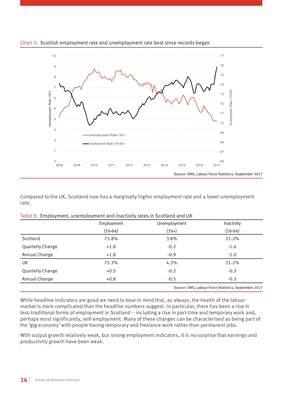
14 Fraser of Allander Institute
Chart 5: Scottish employment rate and unemployment rate best since records began
Source: ONS, Labour Force Statistics, September 2017
Compared to the UK, Scotland now has a marginally higher employment rate and a lower unemployment
rate.
Table 9: Employment, unemployment and inactivity rates in Scotland and UK
Employment
(16-64)
Unemployment
(16+)
Inactivity
(16-64)
Scotland 75.8% 3.8% 21.2%
Quarterly Change +1.8 -0.2 -1.6
Annual Change +1.8 -0.9 -1.0
UK 75.3% 4.3% 21.2%
Quarterly Change +0.5 -0.2 -0.3
Annual Change +0.8 -0.5 -0.3
Source: ONS, Labour Force Statistics, September 2017
While headline indicators are good we need to bear in mind that, as always, the health of the labour
market is more complicated than the headline numbers suggest. In particular, there has been a rise in
less-traditional forms of employment in Scotland - including a rise in part-time and temporary work and,
perhaps most significantly, self-employment. Many of these changes can be characterised as being part of
the 'gig economy' with people having temporary and freelance work rather than permanent jobs.
With output growth relatively weak, but strong employment indicators, it is no surprise that earnings and
productivity growth have been weak.
66
67
68
69
70
71
72
73
74
75
76
77
0
1
2
3
4
5
6
7
8
9
10
2008 2009 2010 2011 2012 2013 2014 2015 2016 2017
Employment Rate (16-64)
Unemployment Rate (16+)
Unemployment Rate (16+)
Employment Rate (16-64)